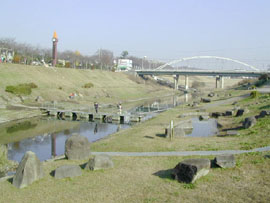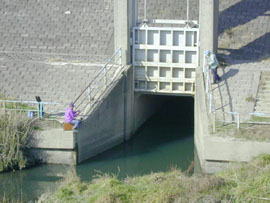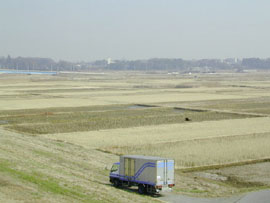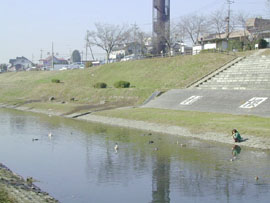The Tone Canal
One in an Occasional Look at Japan's
Public Works Projects
Arriving at my office in the
newsroom after lunch has many advantages. Aside from the
obvious; the fully stocked polyester tie racks in the
train stations and the missed early morning surprise
visits from my loan brokers, perhaps most important is
that junior reporter Junko is usually far too busy to
bore me with one of her lectures on morality, general
decency, and other tired and useless...
 "So
what brings you here today?" came a female voice. I
knew it was her. I didn't need to look - a lack of
subtlety marks her presence like a crack on my skull did
my ex-wife. But I always look anyway.
"So
what brings you here today?" came a female voice. I
knew it was her. I didn't need to look - a lack of
subtlety marks her presence like a crack on my skull did
my ex-wife. But I always look anyway.
I slowly raised my head up from my work
towards the doorway where she was standing. At the time,
my smoke was dangling from my mouth and I was leaning
over my trashcan removing encrusted grass and mud from
my left golf spike with a tee. "Oh, I had some
business this morning," I said. "I went out
for an early morning round."
"You and your drinking," she
said, a little exasperated. But like her inability to be
delicate with conversation, a little disappointment in
my habits is never surprising either.
"Actually I was out playing golf
in Chiba with one of our linotype operators from the
14th floor." I held up my now clean spike as
evidence. "But now that you mention it, we didn't
exactly allow anybody to play through on the 19th
hole..."
"Why wasn't he working
today?"
"Uh...He's sick."
"He's what!"
"Hell, I don't know! What am I,
his mother?" I pulled out my pack of grits from the
top drawer of my desk in anticipation of this
inquisition continuing and started on my right.
"Funny thing though. Since a roundtrip fare across
the Aqualine Expressway to Chiba runs $60, we parked at
the Daikoku Parking Area near Kawasaki and carpooled
across. Saved some dough."
 "Yes,
some of Japan's recent transportation projects have made
little sense as far as their ability to serve the public
properly. For example, in Yamaguchi Prefecture, the
recently completed 1.78 km toll-free Tsunoshima Bridge
cost $149 million and it only serves the 996 people
living on Tsunoshima."
"Yes,
some of Japan's recent transportation projects have made
little sense as far as their ability to serve the public
properly. For example, in Yamaguchi Prefecture, the
recently completed 1.78 km toll-free Tsunoshima Bridge
cost $149 million and it only serves the 996 people
living on Tsunoshima."
"Is that right?" I asked.
"But it wasn't always like that.
The Tone Canal, also in Chiba, played a valuable role in
transporting cargo in the 19th century before later
being surpassed in efficiency by advances made in rail
and road methods in the mid 20th century."
I replaced my dieing smoke with a fresh
one and settled back in my chair.
Designed by Dutch civil
engineer Rouwenhorst Mulder and constructed under the
toil and sweat of some 2.2 million laborers between 1888
and 1890, the Tone Canal was used for 50 years to
quickly shuttle products originating from Japan's
northern reaches down south. Today, with only a small
fraction of the water flowing past its banks from urban
runoff, a tour of the canal shows just how difficult
this task must have been. It also shows that, while
presently not operating as originally intended, the
twisting waterway is still providing a valuable service.
The eight-kilometer canal provided a
navigable connection between two parallel flowing rivers
- the Tone and Edo - and joined the cities of Kashiwa
and Matsudo. The opening of the passage was necessitated
by the desire to create a faster and easier means of
shipping perishable seafood products and staples (rice
and timber) from the northern Tohoku and Hokkaido
regions to Tokyo.
For two kilometers before its
downstream junction with the Edo, the original landscape
on which the canal was constructed is readily visible.
At this point, both sides of this straight section abut
large and flat rice fields and factory complexes. With
the grass-covered embankments rising approximately forty
feet and the bottom widths extending twice that, it is
easy to develop an appreciation for the tremendous
amount of soil that had to be transported during the
construction.
 More
so, considering the modern conveniences not available
back then; the diesel backhoe, the sub-contraction of
cheap foreign labor, and the fast food outlet (not to
mention the convenience store). Though staring upstream
from atop one of the embankments through the factory
haze and beyond the few stray fishermen does explain the
need to utilize 2.2 million pairs of hands, what did a
lunch break look like back then?
More
so, considering the modern conveniences not available
back then; the diesel backhoe, the sub-contraction of
cheap foreign labor, and the fast food outlet (not to
mention the convenience store). Though staring upstream
from atop one of the embankments through the factory
haze and beyond the few stray fishermen does explain the
need to utilize 2.2 million pairs of hands, what did a
lunch break look like back then?
But lunch breaks today are undoubtedly
a different story. Upstream, where the canal crosses the
Noda Line at Unga Station, the landscape and environment
provide quite a contrast to that of its industrial and
agricultural cousin downstream.
Here and further upstream, the canal is
a winding conduit with large trees and homes from many
periods occupying the spaces just beyond its banks. It
is a setting that could easily be confused for a natural
river, not a scene created by shovel, hoe, and beast of
burden over a hundred years prior.
During a typical midday scene, many residents
from the surrounding neighborhoods can be seen utilizing the
canal's meandering paved trails by walking dogs, playing with
their children, tending nearby gardens, flying model airplanes,
or even trying out some new sax parts to anyone that cares
to lend an ear. Government funding, though limited, has enhanced
the experience with the placement of wood viewing stations
interspersed along the canal with the message: kawa wa
mirarete utsukushikunaru (take care of the river and it
becomes beautiful).
Indeed, care of the river has been
undertaken. The continual need to swat at rather thick
swarms of harmless insects, however, does prove to be
distracting from time to time. But beauty is to be had
nonetheless. Thick cattails and reeds rise from its bed,
algae and grass cling to its embankments, and various
waterfowl swim on its water surface. Additionally, small
pontoon bridges allow for easy pedestrian access across
the slow moving ten-meter bottom width. This scene has
further been improved by local folks who have blended
small rock and flower gardens into the sides of selected
portions of the embankments.
 At
its peak, 100 vessels navigated the waterway each day.
Later, after being rendered obsolete, the canal was used
for flood control and as a water source for Chiba
Prefecture. Today, its predominant use is for the
aforementioned recreational opportunities and, as a
result, perhaps the ideal place to practice one's short
game should access to a golf course prove overly
expensive.
At
its peak, 100 vessels navigated the waterway each day.
Later, after being rendered obsolete, the canal was used
for flood control and as a water source for Chiba
Prefecture. Today, its predominant use is for the
aforementioned recreational opportunities and, as a
result, perhaps the ideal place to practice one's short
game should access to a golf course prove overly
expensive.
I set down my clean right
spike and stubbed out my smoke.
"Did I tell you that I really had
my putts draining right into the center of the cup on
the back nine today?" I asked. I thought about
using my empty coffee cup at the edge of my desk as a
visual aid but I didn't want to spook her, like a hunter
might when releasing the safety on his rifle, and send
her fleeing.
"Also there is a commemorative
plaque on one of the banks of the canal to honor
Mulder's work. But it is strange that there is no
mention of the 2.2 million workers," she said
rather quickly, apparently not listening to me.
"But," I added, "I
didn't put one in the drink today. Not one." At
that, she turned and abruptly left the room. I pulled
out my lighter and spun my chair around to face the
window.
Times are certainly shaping up to be
rather dire when she can correctly correlate my
metaphors to a request for a cup of coffee. From now, a
new tact will be necessary.

